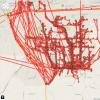Designed for routing, switching, transmitting and / or receiving signs, signals, written text, images and sounds or messages of any kind by radio, wire, optical or other electromagnetic systems between terminal equipment
Departmental communication network- a communication network operated by a legal entity or an individual to meet their own needs.
Examples of telecommunication networks:
1. Components
All telecommunication networks are made up of five basic components that are present in every network environment, regardless of type or use. These major components include terminals, telecommunication processors, communication channels, computers, telecommunications, and control software.
- Terminals are the starting and stopping points in any conditions of the telecommunications network. Any device input or output,
used to transmit or receive data can be classified as a terminal component.
- Telecommunications processors support data transmission and reception between terminals and computers, providing a variety of control and
auxiliary functions. (That is, converting data from digital to analog and vice versa).
- Telecommunications channels are the way in which data is transmitted and received. Telecommunication channels are created using various
media, of which the most popular include copper wires and coaxial cable (SCS). Fiber optic cables are more commonly used to bring faster and more reliable connections to businesses and homes.
- In a telecommunications environment, computers are connected through the media to carry out their communication tasks.
- Telecommunications control software is present on all computers on the network and is responsible for monitoring network activity and functionality.
Early networks were built without computers, but at the end of the 20th century their switching centers were computerized or networks were replaced by computer networks.
1.1. Network structure
In general, each telecommunications network conceptually consists of three parts, or planes (so called because they can be thought of as beings, and often, separately overlaid networks):
- The control plane manages information (also known as signaling).
- Data plane or user plane or bearer plane carries the traffic of network users.
- Traffic management is built on the operational plane.
1.2. Example: TCP / IP data network
The data transmission network is widely used all over the world to connect individuals and organizations. Data networks can be connected to allow users seamless access to resources located outside of the particular provider they are connected to. The Internet is the best example of many data networks from different organizations all operating within the same address space. Terminals attached to the TCP / IP network are resolved using IP addresses. There are different types of IP addresses, but the most common is IP 4. Each unique address consists of 4 integers from 0 to 255, usually separated by periods when written, for example 82.131.34.56. TCP / IP are the main protocols that provide control and routing of messages over data networks. There are many different TCP / IP structures you can use to efficiently route messages, for example:
- wide area networks (WAN)
- metropolitan area networks (MAN)
- local area networks (LAN)
- campus networks (CAN)
- virtual private networks (VPN)
There are three features that distinguish LAN or WAN MANs:
1. The area size of the network is between LAN and WAN. MAN will be a physical space between 5 and 50 km in diameter. 2. MAN usually does not belong to the same organization. The equipment that connects the network, the communications, and the individual himself often belongs to an association or network provider who leases or leases service to others. 3. MAN is a means for sharing resources at high speed within the network. It often provides connectivity to the WAN, networks to access resources outside of the MAN scope
Timely transmission of information is the basis for the stable functioning of many industries and agriculture.
The modern information society is actively using various telecommunication systems to exchange large amounts of information in a short time.
Modern telecommunication systems and networks
Telecommunication systems are technical means designed to transfer large amounts of information through fiber-optic communication lines. Typically, telecommunication systems are designed to serve a large number of users: from several tens of thousands to millions. The use of such a system involves the regular transfer of information in digital form between all participants in the telecommunications network.
The main feature of modern equipment for networks is to ensure uninterrupted connection so that information is constantly transmitted. In this case, a periodic deterioration in the quality of communication is allowed at the time of establishing a connection, as well as periodic technical problems caused by external factors.
Types and classification of telecommunication communication systems
Modern telecommunication systems are combined according to several main features.
Depending on the purpose, television broadcasting systems, personal communications, and computer networks are distinguished.
Depending on the technical support that is used to transmit information, traditional cable communication systems are distinguished, more advanced - fiber-optic, as well as terrestrial and satellite.
Depending on the method of encoding the array of information, analogue communication channels and digital ones are distinguished. The latter type has become widespread, while analog communication channels are becoming less and less in demand today.
Computer systems
Computer systems are a collection of several PCs, united into a single information field by means of cables and specialized programs.
The set of installed equipment and software is an autonomous self-regulating system that serves the enterprise as a whole.
Depending on its functions, the equipment of a computer system is divided into:
- service (for intermediate and backup storage of information);
- active (to ensure timely and high-quality signaling;
- personal devices.
To ensure the operation of the entire system, appropriate software is required, properly configured based on the needs of the users.
Radio engineering and television systems
At the heart of radio-technical message transmission systems are electromagnetic oscillations, which are broadcast over a special radio channel. The unit of operation of the system is a signal that is converted in the transmitting device and then transformed into an information message in the receiving one.
The basis for the uninterrupted functioning of radio engineering systems is the communication line - the physical environment and hardware, which ensure the timely and complete transmission of information.
Television systems operate on a similar receiver and transmitter principle. Most of them use a digital signal to transmit the message in higher quality.
Global telecommunication systems
Global telecommunication systems are those hardware and software that connect users regardless of their physical location on the planet. The main feature of WANs is intellectualization, which makes it easy to use the power of the network with optimal efficiency, while minimizing equipment maintenance costs. There are several main types of global networks.
Digital networks with integrated modules use continuous circuit switching, while data arrays are processed in digital form. Network users have access to only some functions, the interface does not allow changing the technical parameters on their own.
X25 networks are the oldest, most reliable and proven technologies for transferring information between an unlimited number of users. The main difference between such networks is the presence of a device for "assembling" individual blocks of transmitted information into "packets" for the fastest transmission.
Asynchronous data transmission is a modern technology used for broadband networks that are based on fiber optic cables.
Optical telecommunication systems
The basis of optical telecommunication systems is a fiber-optic cable that connects individual devices into a single global network.
Signals are transmitted using the infrared range of radiation, while the throughput of fiber-optic cable is many times higher than that of other types of equipment.
The technical characteristics of the material provide a low level of signal attenuation over long distances, which makes it possible to use the cable for communication between continents. The fiber-optic cable, laid along the ocean floor, is protected from unauthorized access, since it is technically difficult to intercept transmitted signals.
Multichannel telecommunication systems
A distinctive feature of such communication systems is the use of several channels for transmitting information signals.
Modern telecommunication systems use cable, waveguide, radio relay, and space communication lines. The encrypted signal is transmitted at a speed of several gigabits per second over great distances.
The main advantage of multichannel systems is to ensure stable operation. If one communication channel fails, the next one is automatically connected.
Users are protected from sudden disconnections and loss of important information. These systems are based on structured cable structures.
Multiservice telecommunication systems
Multiservice telecommunication systems are hardware and software environments designed for data transmission using packet switching technology - connecting individual blocks of information into large messages.
A feature of multiservice systems is the need to ensure the stable operation of all elements of the transport environment. As a rule, various technologies are used to transfer data, as well as voice and video information, but the infrastructure is the same. Therefore, the main principle of building multiservice networks is the versatility of the technological solution, with the help of which heterogeneous equipment designed to perform various operations is serviced.
A multiservice system uses a single channel to transfer data of various types. This saves on maintenance and hardware costs for the system: a single design requires fewer personnel and costs.
Structure, equipment and components of telecommunication systems
At the heart of any telecommunication system are servers that store and process information necessary for users.
Server rooms are small rooms with industrial ventilation that support many large hard drives.
User computers are a means of communication between the database and specific users of information, performing searches.
The technical basis of telecommunication networks is communication lines, that is, data transmission media, which are used as fiber-optic, coaxial or wireless communication channels.
Network equipment providing data transmission and reception:
- modems;
- adapters;
- routers;
- hubs.
Such devices complement the telecommunications system and are essential for stable operation.
The software allows you to effectively control the operation of the installed equipment, which ensures the timely transfer of information in the required volumes.
Methods and means of measurement in telecommunication systems
Depending on the stage of the measurement, there are three types of measurements:
- Installation measurements are taken after the equipment has been installed to ensure that all nodes of the telecommunications system are working properly.
- In the course of work, it is necessary to carry out adjustment measurements, which make it possible to adapt the functionality of the equipment to changing environmental conditions. For example, if a telecommunications system changes hardware or software, you need to make sure that it continues to function properly.
- Control or preventive measurements are carried out regularly in order to prevent sudden breakdowns of the telecommunications network.
Basics of construction and installation of telecommunication systems and networks
The main principle of building a telecommunications system of any size and purpose is its division into separate functional areas. The maintenance time for each of them is reduced, and the procedure for finding the place of breakdown in case of any technical malfunctions is simplified.
In addition, when installing systems, it is necessary to take care of the insulation of the cable itself, so that the data transfer is as little dependent on external factors as possible. Modern fiber optic cables are placed underground, on the ocean floor or in special corrugations, which maximally protects them from harmful influences.
Ensuring information security of telecommunication systems
The main task in building a security system in telecommunications is to prevent information leakage through separate channels. The reason for such phenomena may be hardware damage to the transmission channel (fiber-optic cable), and an attack by malefactors using software.
In the first case, information security consists in providing high-quality cables that can withstand intense loads and regular operation.
In the second, it is necessary to develop, implement and maintain software that restrict access to the resources of the telecommunication system.
Hotel telecommunication systems
The hotel business is a whole range of services that provide guests with a comfortable stay on the territory of the hotel. That is why the timely provision of complete and reliable information about everything that may interest guests is a guarantee of customer retention.
Typically, telecommunication systems in hotel complexes consist of:
- video communications;
- computer systems;
- software.
Thus, each guest receives the convenience of staying in the room and all the necessary information.
Telecommunication systems and rail transport networks
In contrast to the hospitality industry, the main priority of telecommunications in the railway sector is information reliability. Therefore, telecommunication networks in railway transport are designed in such a way that all transmitted information can be quickly tracked, while minimum attention is paid to possible leaks.
Companies serving telecommunication systems
The maintenance of telecommunication systems is carried out by suppliers of equipment for carrying out these communications and service companies.
Among the enterprises are:
- Telecommunication Systems is one of the oldest specialized companies in St. Petersburg, providing clients with services for the current repair, configuration and maintenance of information transmission systems;
- Stroykom-A is a small company providing maintenance and improvement services for dilapidated telecommunication systems;
- Cryptocom is a narrow-profile company engaged in providing security in telecommunication systems of defense industry enterprises.
Manufacturers and suppliers of equipment for telecommunication systems
The production and supply of equipment for telecommunication systems is carried out by such companies as:
- Montair is a provider of turnkey solutions for telecommunication systems, offering customers a wide range of server equipment.
- "Rdcam" is a full-cycle company that offers customers not only ready-made equipment, but also the development of engineering solutions for telecommunication systems.
- LAN-ART is a supplier of network switching equipment and a manufacturer of communication cables.
Modern telecommunication systems and specialized communication equipment are demonstrated at the annual exhibition "Svyaz".
Read our other articles:Computer telecommunications are used in various spheres of modern society: business, finance, banking, and the media.
Telecommunications- in the broad sense of the word, means of remote transmission of information, such as radio, television, telephone, telegraph, teletype, telex, telefax, as well as relatively recently appeared computer telecommunications.
Computer telecommunications or telecommunications in the narrow sense is a means of remote transmission of information between computers using various communication channels.
At the heart of computer telecommunications are three main elements: computer, modem, telephone network.
You cannot transfer data directly from one computer to another via telephone lines, since the computer uses digital signals, and telephone lines are analog. Converting digital signals to analog signals is called modulation, and the reverse process is called demodulation. Perform such a transformation modem.
Modems are available in two types: built-in and external. The most famous companies that produce high quality modems: Hayes Microcomputer Products, US Robotics, Multech, Paradyne.
Modem characteristics:
1. The baud rate reflects the number of bits transmitted per second. The most common modems are 1200, 2400 and 9600 bps. The maximum speed is approximately 3800 bps. Obviously, the higher the speed, the more information can be transmitted per unit of time. On the other hand, not all high-speed modems can withstand the outdated telephone equipment in our country. And besides, the higher the data transfer rate, the higher the probability of data errors. Therefore, the modem must support MNP Standard Error Correction Protocol. There are currently 10 classes of protocol. Starting with class 5, the protocol not only allows error correction, but also data compression. MNP protocols are built into the modem and start automatically.
2. The modem must be Hayes-compatible, ie. execute a certain standard set of commands developed by Hayes Microcomputer Products. Most of the commands for such modems begin with the letters AT.
Modems operate in full-duplex or half-duplex data transmission mode. In full duplex mode, data is transmitted through the modem in both directions. In half-duplex mode, data is transmitted in one direction at a time. This scheme is convenient when one-way data transfer is needed (faxes, file transfer), but is not suitable for interactive access (like in BBS).
In addition to its main purpose, the modem performs many other functions. For example, he can automatically dial to the subscriber, answer a phone call, or report the state of the telephone line at the moment. The modem performs all these functions under the control of a computer.
When several communication systems are combined, telecommunication computer network... Most of the computers connected to the network perform the functions of subscriber points.
Subscriber point- this is a user's workplace, who, having a computer, peripheral equipment, modem, telephone, can connect to any network and receive or transmit information.
In order for computer systems to form a single whole, and information over the network was transmitted around the clock, there are computer communication nodes in the network, which are called host computers(Host-master) Host computers with modems are permanently connected to the telephone network and all subscribers communicate through them.
Most of the existing networks are small computer networks that have only one host computer.
The next type of networks are global networks that connect large node computers. Data transfer between such computers is carried out via satellites or through dedicated channels. The most famous global Internet. Domestic networks - Relcom, Glasnet, Rico.
After connecting the network, a registered user is provided with a variety of services, among which the main ones are:
computer interpersonal telecommunications (messaging, electronic newsletters, teleconferences, etc.);
access to remote databases.
The whole set of computer communication systems and information flows of various natures circulating in world networks is called cyberspace.
Created on a computer screen using computer technology images real objects and processes of a diverse nature - people, musical instruments, appliances, machine tools, works of art, etc. are called virtual reality Of course, these are not “photographs” of objects (even if they are moving, as in a movie), with which you have no contact, but quite tangible objects. You can work with them as with a real thing (for example, tune and play the piano), conduct research and test.
Thus, cyberspace and virtual reality, which are gradually entering our lives, introduce us to the information resources of all mankind, expand our horizons and change the very way of life.
The exchange of information using computer networks is called computer telecommunications.(CT). It differs from transmission by mail, telegraph, using radio communications in that information is processed and created in the process of transmission. CT makes it possible to create information systems for collective use that exchange information both between several computers, a user and a remote computer, and between users through a computer.
CT is being implemented in local area networks (LAN) at the level of the enterprise, organization, at the regional (territorial) level (corporate, city networks, etc.) and globally at the national and international level.
Computer telecommunications are direct computer communication lines, various communication systems and communication equipment: telephone, radio communication, fiber-optic and space (satellite)... CT makes it possible to quickly exchange information, including the ability to work in real time.
Communication can be established between two stand-alone PCs and with a remote subscriber - another PC or fax (modem connection). For the first type of communication, the software supports file exchange between PCs via cable via serial ports. To support modem communication, a PC requires more sophisticated software, but the capabilities of such communication are much higher - voice information and digital information (ISDN technology) are simultaneously transmitted over the same telephone line.
Computer (computing, informational) networks based on CT and PC of mass distribution enable PC users connected to communication lines and having the necessary devices (modem, fax modem, network card) and telecommunication software to send messages by e-mail, participate in teleconferences, perform banking and trade operations , receive information from banks, databases and knowledge, etc.
Initially, COPs had serial, circular(1970s), star-shaped or backbone structure (topology) of subscriber connections. For example, Xerox's ETHERNET CS had a backbone structure with a bidirectional communication line.
Regional network is formed by linking local COPs into a single network of a particular topology. In turn, the unification of regional networks gives a global network. The connection of the CS is carried out using special devices, powerful computers or PCs and complex technical systems - telephone networks, satellite and fiber-optic and other communication systems. Identical networks are connected using a bridge - this is the simplest connection. The communication of networks based on the gateway is carried out when it is necessary to translate recipient addresses and reformat the data. Communication of the COP through a repeater implements the accumulation of data.
Communication between the COP and the PC is carried out via dedicated and wireless lines. Offices, hotels, other institutions and private homes are equipped with a LAN to connect to the global network from any room.
Data transfer to the CS is based on two methods- channel switching and packet switching. Channel switching is carried out for the duration of the communication session (for example, telephone communication). The communication line remains busy all the time the message is being sent. Data is transmitted in small frames with error checking in every frame. There are CS with message switching, which does not block the entire transmission path, as in channel switching, but only a part between the nearest repeaters.
Channel switching is used when high reliability, high noise immunity and confidentiality of communication are required (for example, between government agencies, heads of state, in the military sphere, etc.).
When switching packets, messages are split into packets of a fixed length (128 bytes, etc.), provided with markers with the sender and receiver addresses and the packet number, and sent over the network as independent messages. The packets accumulated in the buffer of the communication node, belonging to different messages, are transmitted to the neighboring communication node. At the destination, the interface processor combines the packets into a single message and issues them to the addressee.
The method of switching packets and transmitting them along different routes increases the reliability and shortens the transmission time of messages, providing higher throughput, in particular, of short messages, which effectively supports the real-time dialogue mode, which is popular in the modern world.
In the initial period of the creation of the CS (1970s), their differences made it difficult to integrate into global networks. But as a result of the development of the CS, a hierarchical approach to networking was formed, embodied in the standard open systems communication model (OSI architecture) of the International Organization of Standards (ISO).
The "Computer Telecommunications" section is focused on the basic level recommended by the school curriculum, but easily develops into one or two elective courses ("Computer Networks", "Site Building") with the involvement of additional material and the expansion of the set of workshops and projects. These extensions are contained in the Getting on the Internet tutorial above.
Computer network (CS) - a set of computers and terminals connected using communication channels into a single system that meets the requirements of distributed data processing2, p. 205.
In general, under telecommunication network (TS) understand a system consisting of objects that perform the functions of generating, transforming, storing and consuming a product, called points (nodes) of the network, and transmission lines (communications, communications, connections) that transfer the product between points1, p. 421.
Depending on the type of product - information, energy, mass - one distinguishes, respectively, information, energy and material networks.
Information network (IS) - a communication network in which information is the product of the generation, processing, storage and use of information. Traditionally, telephone networks are used to transfer sound information, images - television, text - telegraph (teletype). Nowadays, information integrated service networks, allowing to transmit sound, image and data in a single communication channel.
Computing network (BC)- information network, which includes computing equipment. The components of a computer network can be computers and peripheral devices that are sources and receivers of data transmitted over the network.
The sun is classified according to a number of characteristics.
Depending on the distance between the nodes of the network, the aircraft can be divided into three classes:
local(LAN, LAN – LocalAreaNetwork) - covering a limited area (usually within the distance of stations no more than a few tens or hundreds of meters from each other, less often by 1 ... 2 km);
corporate (enterprise scale)- a set of interconnected LANs, covering the territory on which one enterprise or institution is located in one or more closely located buildings;
territorial- covering a significant geographic area; Among the territorial networks, one can distinguish regional (MAN – Metropolitan Area Network) and global (WAN – Wide Area Network) networks, which have regional or global scales, respectively.
The global Internet is especially distinguished.
An important feature of the classification of computer networks is their topology, which determines the geometric location of the main resources of a computer network and the connections between them.
Depending on the topology of the nodes' connections, there are bus (backbone), ring, star, hierarchical, and arbitrary structures.
Among LANs, the most common are 1, p. 423:
tire (bus) - a local network in which communication between any two stations is established through one common path and the data transmitted by any station simultaneously becomes available to all other stations connected to the same data transmission medium;
annular (ring) - the nodes are connected by a circular data line (only two lines are suitable for each node). The data passing through the ring becomes available to all network nodes in turn;
starry (star) - there is a central node from which data transmission lines diverge to each of the other nodes.
The topological structure of a network has a significant impact on its throughput, network resilience to equipment failures, and the logical capabilities and cost of the network.
Depending on the control method, networks are distinguished:
Client-server- one or several nodes (their name is servers) are allocated in them, performing control or special service functions in the network, and the rest of the nodes (clients) are terminal, users work in them. Client-server networks differ in the nature of the distribution of functions between servers, that is, according to the types of servers (for example, file servers, database servers). When specializing servers for certain applications, we have distributed computing network. Such networks are also distinguished from centralized mainframe systems;
peer-to-peer- in them all nodes are equal. Since, in general, a client is an object (device or program) that requests some services, and a server is an object that provides these services, each node in peer-to-peer networks can perform the functions of both a client and a server.
Depending on whether the same or dissimilar computers are used in the network, networks of the same type of computers are distinguished, called homogeneous, and different types of computers - heterogeneous (heterogeneous). In large automated systems, networks tend to be heterogeneous.
Depending on the ownership of the network, they can be public networks (public) or private (privat).
Any communication network should include the following main components: transmitter, message, transmission media, receiver.
Transmitter - device that is the source of the data.
Receiver - device receiving data.
The receiver can be a computer, terminal, or some kind of digital device.
Message - digital data of a specific format intended for transmission.
It can be a database file, table, query response, text, or image.
Transmission media - physical transmission medium and special equipment providing transmission of messages.
Various types of communication channels are used to transmit messages in computer networks. The most common are dedicated telephone channels and special channels for transmitting digital information. Radio channels and satellite communication channels are also used.
Communication channel call the physical environment and hardware that transfer information between switching nodes1, p. 424.
The need for the formation of a single world space led to the creation of the global Internet. Currently, the Internet attracts users with its information resources and services (services), which are used by about a billion people in all countries of the world. Network services include bulletin boards (BulletinBoardSystem – BBS), e-mail (e-mail), newsgroups or newsgroups (NewsGroup), file sharing between computers (FTR), parallel conversations on the Internet (InternetRelayChat – IRC), search engines " World Wide Web ".
Every local or corporate network usually has at least one computer that has a persistent connection to the Internet using a high-bandwidth communication line (Internet server).
The Internet provides a person with inexhaustible opportunities to find the necessary information of a various nature.
Almost all programs contain, in addition to the help system, electronic and printed documentation. This documentation is a source of useful information about the program and should not be neglected.
Acquaintance with the program begins with the information screens accompanying its installation. While the installation is in progress, you should learn as much as possible about the purpose of the program and its capabilities. This helps you understand what to look for in the program after installing it.
Printed documentation is included with store-bought software. These are usually fairly extensive manuals up to several hundred pages in length. It is the length of such a manual that often stifles the urge to read it carefully. Indeed, it makes no sense to research the manual if the answer to the question can be obtained by simpler means. However, in case of difficulty, the program manual is one of the most convenient sources of the necessary information.
In many cases, additional help information on the program is presented in the form of text files included in the distribution kit. Historically, these files are usually named README, derived from the English phrase: "Readme".
Typically, the README file contains information about installing the program, additions and clarifications to the printed manual, and any other information. For shareware and small utilities distributed over the Internet, this file may contain the complete electronic version of the manual.
Programs distributed over the Internet may include other text information files.
In cases where no "ordinary" sources allow you to obtain the necessary information about the program, you can turn to the bottomless treasure of information that is the Internet. Finding information on the Internet is fraught with some difficulties, but on the Internet there are answers to any questions.
All major companies and authors producing software for computers are represented on the Internet. Using a search engine, it is easy to find the Web page for the program or series of programs you are looking for. Such a page may contain an overview or a short description, information about the latest version of the program, "patches" related to finalizing the program or fixing errors, as well as links to other Web-documents devoted to the same issues. Here you can often find free, shareware, demo and trial versions of programs.
The Internet is growing at a very fast pace, and it is becoming increasingly difficult to find the information you need among the billions of Web pages and files. To find information, special search engines are used, which contain more or less complete and constantly updated information about Web pages, files and other documents stored on tens of millions of Internet servers.
Different search servers can use different mechanisms to search, store and present information to the user. Internet search engines can be divided into 2 groups:
general search engines;
specialized search engines.
Modern search engines are often information portals that provide users not only with the ability to search for documents on the Internet, but also access to other information resources (news, weather information, exchange rate information, interactive geographic maps, and so on).
General purpose search engines are databases containing thematically grouped information about the information resources of the World Wide Web.
These search engines allow you to find Web sites or Web pages by keywords in a database or by searching a hierarchical directory system.
The interface of such general purpose search engines contains a list of catalog sections and a search field. In the search field, the user can enter keywords to search for a document, and in the catalog, select a specific section, which narrows the search field and thus speeds up the search.
The databases are filled with special robotic programs that periodically "bypass" the Internet's Web servers.
Robot programs read all documents they encounter, highlight keywords in them, and enter them into a database containing document URLs.
Since information on the Internet is constantly changing (new websites and pages are created, old ones are deleted, their URL addresses change, and so on), search jobs do not always have time to track all these changes. The information stored in the database of the search engine may differ from the real state of the Internet, and then the user, as a result of the search, can get the address of a document that does not already exist or that has been moved.
In order to provide a better match between the content of the search engine database and the real state of the Internet, most search engines allow the author of a new or relocated website to enter information into the database by filling out a registration form. In the process of filling out the questionnaire, the site developer enters the site's URL, its name, a brief description of the site's content, as well as keywords by which it will be easiest to find the site.
Sites in the database are recorded by the number of their visits per day, week or month. Website traffic is determined using special counters that can be installed on the website. Counters record each visit to the site and transmit information about the number of visits to the search engine server.
The search for a document in the database of the search engine is carried out by entering queries into the search field. A simple query contains one or more keywords that are central to this document. You can also use complex queries using boolean operations, patterns, and so on.
Specialized search engines allow you to search for information in other information "layers" of the Internet: file archive servers, mail servers, etc.














